Abstract
For millennia, the coastal heathlands of Western Europe were managed by regular burning cycles for improved grazing. In recent decades, this practice has generally been neglected. In Norway, the result is accumulation of degenerated heather and highly combustible Juniperus communis (juniper) encroachment, i.e., an increasing fire threat to a rising number of homes in the wildland–urban interface (WUI). In the present study, goats grazing a 1.2 ha site partly encroached by fire-prone juniper were studied in a living lab approach. Twelve wethers (castrated male goats) wearing solar-powered Nofence GPS collars were virtually fenced to protect villa gardens bordering the site during eight weeks from 18 April 2022. Besides some early operator errors, tree shadows and cloudy days limiting battery charging, the system worked well. Photographs taken prior to and after the grazing revealed that only 39% of the junipers had 90+% remaining foliage while for 41%, the foliage was reduced to below 10%, making them far less fire-prone. The goats were frequently visited by neighborhood residents of all ages, school classes, and kindergartens. Moreover, local newspapers and TV stations broadcasted the initiative. Although divided regarding debarked deciduous trees, the neighbors stated that the goats were well accepted. Despite some limited loss of garden plants, all interviewed residents bordering the site were positive about the goats “bringing life to the forest” and, if possible, welcomed them back for other grazing periods. Virtually fenced grazing goats may represent a sustainable solution for reducing fire hazards in the WUI also elsewhere.
1. Introduction
During the past century, wildland fires represented an ever-increasing threat in most fire prone-areas worldwide [1]. In the transition zone between wilderness (unoccupied land) and land developed by human activity, i.e., the wildland–urban interface (WUI), fires pose a hazard to people, homes, and other infrastructures [2,3,4]. Combined, climate and land cover changes may lead to large fires striking several communities and thereby threatening life and structures directly as well as by blocking escape routes, etc. [5,6]. Land use and land cover changes are identified by the EU as the main drivers of the increasing WUI fire trend [7] and managing the WUI vegetation may be very beneficial [8].
Prescribed burning was generally prohibited for decades in, e.g., the USA, Portugal, Spain, and Greece [9,10,11]. The following biomass accumulation eventually resulted in even more severe fires. Ramping up firefighting efforts to keep pace with the growing challenges is not possible. Today, an increasing number of wildfire prevention stakeholders [7,12,13,14,15] highlight the fact that traditional landscape and resource management, including prescribed burning and grazing, may prevent severe WUI fires.
Anthropocene landscape management by fire by far predates written history [16,17,18,19]. Along the Atlantic coast of Europe, Calluna vulgaris-dominated heathlands have been managed by regular 10-to-15-year burning cycles and livestock herding for the past 5–6000 years [11,12,16]. This landscape is also important for its intrinsic value while supporting a variety of plants, insect, amphibians, reptiles, mammals, and bird species. The Calluna is also known for its many nutritional and medicinal properties as well as the fine-tasting honey produced in Calluna-dominated heathlands [20]. This symbiotic human–herbivore–Calluna relationship led to smoke-adapted germination [21] not found in unmanaged Calluna, e.g., at high altitudes. Traditional landscape and resource management, including regular prescribed burning intervals, efficiently prevented severe wildfires in the costal heathlands [12,13,14,15,22].
During the past 6–7 decades, the traditional management of Calluna-dominated heathlands in coastal Norway gradually ceased. This was partly due to changing agricultural practices [23] as well as improved career prospects following the general industrialization and the discovery of North Sea oil in 1969. After the Second World War, forestry was introduced in the coastal heathlands to support local economic growth. By the turn of the century, fewer than 10 per cent of the Calluna-dominated heathlands in Norway were still preserved [24]. Today, backed by scientific research, the Norwegian government supports projects to restore the traditional heathlands for conservation purposes [25,26].
Declining landscape management in the coastal heathlands has led to an invasion of rapidly spreading Sitka spruce (Picea sitchensis (Bong.) Carr) and native juniper (Juniperus communis). These represent highly combustible fire fuel. The juniper foliage contains about 1% essential oil [27] and is known to “explode in fire” [12] and may act as ladder fuel for taller trees. It has been a critical fuel in recent wildfires in coastal Norway [28].
Following the discovery of North Sea oil and gas resources, numerous new wooden homes were built in the WUI and the wildland–urban intermix along the prosperous west coast of Norway [28,29]. In January 2014, during sub-zero temperatures, communities in Flatanger and Frøya, respectively 210 km and 320 km south of the Polar circle, experienced the consequences of neglected heathlands through 15 km2 and 10 km2 wildfires [30]. The Flatanger fire destroyed more structures than any single fire in Norway since 1923 [31]. The soil fortunately contained sufficient humidity (ice) to prevent soil combustion, and the affected heathland is currently re-establishing. In some areas initiatives for resuming the heathlands have recently been undertaken by civic farmer groups [12,23]. In most areas, however, the encroachment continues unconstrained. This has resulted in an increased number of fires [32] where the lack of land management in the previously Calluna-dominated heathland represents an increasing fire threat. A recent study demonstrated that Norwegian municipalities supporting land management statistically experienced substantially less cost associated with wildland firefighting [33]. There is a need to understand, and manage, the increasing vegetation WUI fire hazard in cost-effective ways [4].
Detached, semi-detached, or terraced homes in Norway are generally heated by electricity, but are also commonly equipped with wood-burners, a safety measure in cold climates in case of power outages. Rural households consume more wood than urban households [34] and there is a strong possibility for these households to harvest firewood in the vicinity of the homes. Given soaring electricity prices and efficient modern wood-burners [35], upright junipers may very well serve as free fire fuel, while it is far more cumbersome to utilize prostrate (quite tortuous) juniper [28]. Goats grazing the WUI, as reviewed for more fire-prone areas by Lovreglio et al. [36], may help consume the remaining junipers.
The homeowners’ vegetation preferences, previous experience with wildfire, etc. may vary with other elements of the local context regarding efforts to create “fire-adapted communities” [37]. This may include their identification as “suburbanites” or “country residents,” a desire for privacy, preferences for wildland or ornamental vegetation, willingness to collectively organize, etc. Most of this will likely be quite similar in Norway. However, to make people join in toward collective efforts may be easier than elsewhere due to the “dugnad” concept, i.e., voluntary work carried out collectively (traditionally involving societal work gatherings for a common benefit) [38]. Dugnads are usually set up to support local schools, kindergartens, playgrounds, sports clubs, etc. It may also be a neighborhood federation gathering participants to refurbish the WUI for the benefit of the locals. The Bjøllehaugen Neighborhood Federation (BNF), Haugesund, Norway, initiated such an initiative and the present study was facilitated in collaboration with them. Contact was established to possibly study how goats could contribute as “first respondents” prior to any public “dugnad” involving mechanical cutting and removal of biomass. A goat grazing project was aligned with the BNF, whose first priority was to refurbish a local playground. Thus, goats could be introduced to an encroached piece of land sharing borders with 28 villas, prior to any human intervention. This is in line with the concept recently outlined as a response to a 700 ha wildfire at Sotra, Norway, where the fire managers asked for an “army of goats” to help maintain the biomass to prevent future fire incidents [28].
For goats to stay in place and not rampage through neighboring gardens, fences would be required. However, fencing is expensive and would likely not be well received by the villa owners. Virtual fencing technology, Nofence (Nofence.no, Batnfjordøra, Norway), is gaining popularity [39,40,41,42], and could represent a cost-effective non-invasive scalable fencing solution. This system relies on associative learning from audio cues prior to a mild electric shock. The audio cues are only activated if animals are at or outside the set borders. If an animal does not return to the allowed grazing area it receives a mild electric shock. Thus, virtually fenced goats may remove fire-prone biomass close to homes where prescribed burning would be too dangerous. Moreover, grazing would be beneficial also after manual removal of fire-hazardous biomass, i.e., to prevent regrowth. However, some important questions need to be answered if grazing goats bordered by virtual fences could represent a solution for reducing fire-prone biomass in the WUI:
- Can the Nofence virtual fences prevent the goats from creating too much havoc?
- Will the goats consume sufficient junipers and other fire prone biomass in the WUI?
- How do adjacent villa owners respond to virtually fenced goats in their “backyard”?
The purpose of the present study is to report on, and analyze, the use of goats for virtually fenced grazing close to villas at Bjøllehaugen, Vormedal, Norway, and answer the listed research questions. The goals were to verify that goats can reduce the most fire-prone biomass close to the villas, i.e., juniper, to evaluate the pros and cons of virtually fenced goats and interview villa owners to learn about their experience with virtually fenced goats. Section 2 presents the approaches used, the area of interest and the Nofence technology, as well as the goats involved. Section 3 describes experiences regarding the Nofence system, photographic evidence of juniper- and other fire-prone trees consumed or debarked by the goats, goat weights prior to and after 8 weeks of grazing and findings from the interviews. Methods, results, and suggestions for future mitigation measures are discussed in Section 4. The main takeaways are presented in the Conclusions.
2. Research Approach, Test Location, Goats, and Virtual Fencing Technology
2.1. A Living Lab Approach
The approach of the present study has many similarities to the living lab methodology, i.e., centered around co-creation of an innovative use of goats through end-user involvement and experimentation in a real-life context [43,44]. It follows the living lab research approach as an iterative cycle, including exploration, co-creation (design), testing, and evaluation. However, implementation, i.e., upscaling, the final part of the living lab methodology [44,45], was not within the scope of the present study, as presented in Figure 1. Nevertheless, the present study may pave the road for future upscaling.

Figure 1.
Stages associated with living labs. Implementation was outside the present study’s scope.
Exploration includes the referred research and ideas presented in the Introduction, while co-creation (design) will be presented in this section. The progress of the study was defined by what could be done within reasonable cost and time frames. A location close to the university had to be identified to be able to follow up in case of any unforeseen incidents involving goats, neighboring gardens, etc. Since the present study was a real-life approach, the researchers had to be open to surprises along the way. A living lab approach allows for adjusting parameters throughout the research process if this is beneficial to the progress of the project, as exemplified by the arrows in Figure 1.
2.2. Location and Initiation of the Goat Grazing Project
The 1.2 ha test site at Bjøllehaugen (N 59.3600, E 5.3215), Figure 2, in Karmøy municipality, is about 7 km south of Haugesund town center. The name Bjøllehaugen would in English translate as “(sheep) bell hill” indicating an area previously used for sheep grazing until naturally afforested by pines (Pinus sylvestris) 60–70 years ago. Traces of the original Calluna heathland can still be spotted at the site as well as in adjacent private gardens.
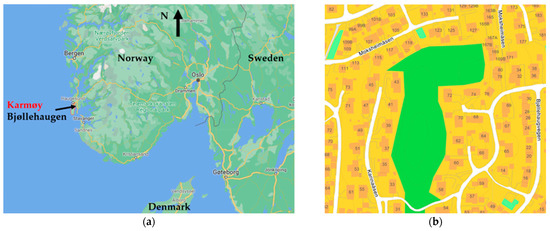
Figure 2.
Location of the Bjøllehaugen test site on the Atlantic coast of Norway (a) and map of the test site (dark green) with wooden villas at N 59.3600, E 5.3215 (b).
Today, the site is dominated by upright and blown-over tall pines with a few native spruces (Picea abies), Sitkas and scattered deciduous trees, e.g., birch (Betula pendula), willow (Salix caprea), rowan (Sorbus aucuparia) and common holly (Ilex aquifolium). The forest floor is rich in plant species. Areas facing west are partly covered by Calluna and similar plants while various grasses dominate in the north (more humid area). The most conspicuous cover is blueberry (Vaccinium myrtillus), dominating large parts of the east- and west-facing slopes, which is popular for berry picking in the summer. A few non-native plants, e.g., variants of rhododendron, poisonous to goats, have been planted within the site. Compared with other WUI areas along the west coast of Norway, the test site is much less dominated by juniper encroachment than, e.g., Sotra where a 700 ha fire destroyed and damaged homes in June 2021 [28]. However, the selected site has a common border with 28 villas and is within 10 minutes’ drive of the university facilities in Haugesund.
The privately owned site remained unbuilt due to building regulations. There used to be a footpath through the site from south to north, currently blocked by uprooted trees in this wind-exposed region. The site may be described as chaotic in terms of accessibility and aesthetic value. The Bjøllehaugen Neighborhood Federation (BNF), formed in January 2022, therefore wanted to develop a park-like natural forest site accessible to people of all ages [46]. This would include restoring the path through the site and placing park benches at viewpoints. The planned dugnad would produce firewood while leaving some trees and branches to the course of nature to the benefit of organisms dependent on old and decaying wood.
When contacted, the BNF board members were quite enthusiastic about goats doing an initial job of reducing fire-prone biomass. A formal application was sent to the BNF board, who unanimously supported the initiative. The landowner had already allowed for cutting and removing trees to upgrade the path, etc. and also gave permission for goat grazing. The municipality land office was contacted. They had no objections and wanted to be informed when the research results could be released.
The BNF board sent information about the goat grazing project to each adjacent villa owner by mail and informed about the project on social media platforms. They advised about restricting dogs from entering the site, that small kids should not approach the goats unattended, and that no food should be brought to the goats, e.g., a kid with a carrot or a piece of bread could easily lead to excessive attention from the goats.
2.3. The Goats and the Nofence Virtual Grazing Technology
Twelve Kashmir wethers, six one-year-olds and six two-year-olds, rented from Geiteprodukter.no (Goats Products, Inc., Skjold, Norway) were selected for the grazing. The goat owner sorted out the goats based on behavioral patterns, i.e., goats accustomed to virtual fences and contact with people. The goats were weighed prior to transport to the Bjøllehaugen test site on 18 April 2022; see Appendix A.
The concept of virtual fenced grazing has evolved in Norway during the past 3–4 years following the Ministry of Agriculture’s approval in 2018 of the Nofence system (Nofence AS, Batnfjordøra, Norway) [39,40], conceived as an alternative to hiring personnel to cut lawns. The idea remained dormant until the global positioning system (GPS) could deliver position data to low-cost devices [40]. After approval, the system quickly gained momentum as electricity companies wanted to rent goats for clearing vegetation under power lines in difficult terrain. Today, the system is also accepted for virtual fencing of cattle and sheep. It is also gaining popularity elsewhere, e.g., in Denmark and Italy [41,42].
During grazing, each mature animal carries a neck collar which connects to the internet to load virtual fence data and report information to a central server. The collars contain batteries and a photovoltaic charging system. A phone app is used to set the borders and place each collar within the defined area. By September 2022, the system involved 3200 customers, 48,000 animals and a total of 266 million grazing hours (www.nofence.no, accessed on 1 September 2022). The cost for renting goats in Norway is typically EUR 4 per day per goat.
When arriving at Bjøllehaugen, the goat owner first set the borders a little wide prior to releasing the goats and guided them well into the area by serving concentrated foodstuff pellets (concentrate). The system automatically gave information when each collar was transferred to the new grazing field, for simplicity’s sake named Bjøllehaugen. When all the collars were within the site, the grazing borders were adjusted, and the goats were left to settle down and learn the new borders. The goat owner then gave the researchers full access to modify borders through the phone app. The borders for the first grazing days are shown in Figure 3a. The corresponding information about battery levels on each collar is shown in Figure 3b. The researchers also received a battery charger, four spare batteries and one spare collar in case replacement should be necessary.
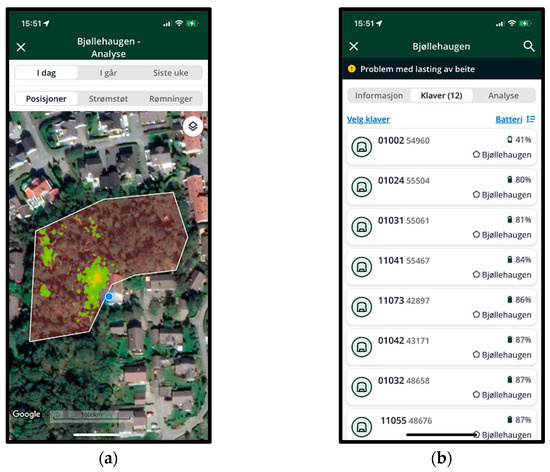
Figure 3.
Aerial overview of the first days of Bjøllehaugen virtually fenced grazing area (a) and details of the battery charge level for the 8 collars with lowest charging level that day (b).
When an animal later crossed the virtual border, the collar initiated a gradually increasing conspicuous sound and gave the animal 8 s to return to within the borders, which it generally did. If the animal did not return within this period, it was exposed to a light electrical shock through the collar neck contacts. When left in peace, the goats quickly learned the new borders and generally returned prior to an electric shock.
The goats had access to a regularly refilled water tray and a salt stone. To catch goats more easily for, e.g., replacing batteries, the researchers regularly socialized with the goats to keep them tame. Twice a week, and during the first two weeks a little more frequently, the goats were offered concentrate to support their familiarization; see Figure 4.
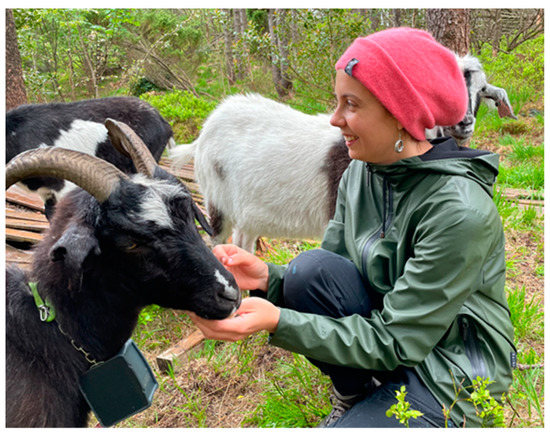
Figure 4.
The leader goat (# 01002) socializing with a researcher.
2.4. Methods for Interviewing the Grazing Field Neighbors
All 28 villas bordering the grazing area are wooden constructions in line with Norwegian local building traditions. Thus, the villas did not have much built-in safety regarding potential fire spread from the vegetation to the homes. This made the site relevant regarding possible WUI fire risk and possible risk-reducing measures.
To utilize grazing animals in the WUI adjacent to private homes and gardens, acceptance from the public is essential. It was therefore decided to interview the neighbors living in properties bordering the grazing area presented in Figure 2. The interviews were conducted to learn about the community perception of virtually fenced goats grazing along their borders and to reveal any possible motivation regarding fire hazard mitigation. The project was approved by the Norwegian Centre for Research Data.
As mentioned previously, the BNF had already informed residents about the plans regarding the footpath, benches at viewpoints, etc. and then informed all homeowners adjacent to the selected grazing field prior to the arrival of the goats. This included a brief introduction to the virtual fencing system, general precautions, etc.
Following the 8 weeks of grazing, the researchers contacted these homeowners by written information placed in their mailboxes and by SMS to inform them about upcoming interviews regarding the grazing project. The interviews were semi-structured [47,48], following a preliminary guide, with the possibility of discussions during the interview session. The interview format contained open-ended questions designed to record respondents’ beliefs and attitudes about the goat grazing WUI fire safety initiative. Specifically, questions were aimed at capturing perceptions of wildland fire risk, level of support regarding goats for reducing the WUI fire hazard, any experience with the goats and opinions on the project in general. Moreover, the interviews were also used to inform the homeowners about WUI fire risk associated with junipers and dry cured grass close to the homes. Each interview lasted between 15 and 30 min and was conducted by two researchers.
3. Results
3.1. Experience with the Nofence Grazing System
None of the researchers involved had any previous experience with the Nofence technology. Some beginner errors were therefore experienced regarding, e.g., replacement of batteries, etc. The click-in-lock position during replacement of collar batteries was missed twice, i.e., the batteries fell out and had to be retrieved in the field. In both cases, the app warned about the loss of reporting and kept track of the last reported position to support search missions. The batteries were found within 5–15 m of the reported positions. By offering concentrate, the goats in question were caught and the batteries reinstalled.
The initial stress of replacing low batteries with topped-up batteries was probably a major cause of the beginner error resulting in loss of batteries. While later applying some self-taught tricks of the trade, and having more socialized goats, battery changes could easily be performed by one person. This involved catching the goat in question by offering concentrate and securing it by rope, if necessary, after first having provided concentrate to the rest of the herd to keep them at some distance.
In one case, a collar was lost just after a battery change. A small metal part had to be bent in place on the collar, which worked flawlessly afterwards. On two occasions, collars fell off with no previous anomaly. In the first case, the app reported a “runaway goat”, i.e., it did not return after the allowed maximum number of mild electric shocks. That message stressed the researcher in charge, but while approaching the herd, the goat in question was observed to unaffectedly graze with the herd well within the borders. The built-in Bluetooth positioning came handy, i.e., when approaching the lost collar, the Bluetooth collar sound was activated, and the collar was found within a few seconds. The collar was probably lost just outside the border as the goat was caught by the edge of a children’s sandpit in a private garden. The collar yielded, as it should, to prevent the goat from being stuck. The goat was fed concentrate, had its collar replaced, and happily kept on grazing with the herd.
Another collar once reported “stagnant goat” within the borders. The researcher in charge rushed to the location in case the goat was stuck, ill, or dead, and quickly located the collar where it was reported stagnant assisted by the Bluetooth sound. The goat was, however, spotted grazing in a neighbor’s garden, while other goats that tried to follow received sound warnings. The goat in question was fed concentrate and happily aligned with its collar and the herd. Meanwhile, the neighbor called one of the other researchers to inform them about a no-collar visitor in their garden, fortunately not creating too much havoc.
The goats quickly learned the borders, and later learned to stretch the limits during the 8 s period prior to electrical shock. Some goats experienced up to 67 warning signals during a day while receiving one shock, i.e., termed “musical-goats” by Vik and Søraa [39]. During the 8-week grazing period, the borders were extended southwards to adjust them according to the food access. To avoid complicated borders, some borders were set too close to villa gardens, and one bed of tulips became goat forage. Later, the goats learned to stretch the limits to eat roses from another villa and quickly run back to avoid the electric shock. Thus, the borders had to be adjusted to compensate for the goats’ creativity.
To prime the goats for juniper consumption, initially foliage shed from junipers collected elsewhere was placed in the feeder tray together with concentrate. The goats carefully sorted out and ate the concentrate while leaving the juniper foliage untouched. The next day, however, all juniper foliage was eaten. The following day, the researchers brought new junipers to supply foliage. The goats did, however, see the approaching researcher and rushed to consume foliage from the branches; see Figure 5. This revealed that feeding juniper was indeed quite easy when done where they used to receive concentrate. The goats were later regularly observed eating juniper foliage, mostly as a common activity, i.e., they all ate the same juniper(s) and even fought for their position “at the table”.
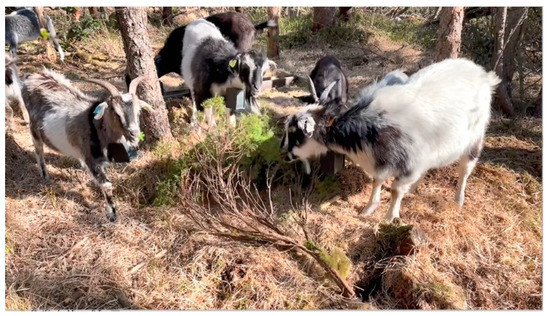
Figure 5.
Goats eating juniper foliage rather than letting the researchers strip the foliage for them.
One neighbor wanted the goats to graze as close to their home as possible so that they would eat excessive small deciduous trees in their garden. To avoid complicated zigzag borders confusing the goats, the border was drawn through a garage. Due to the sloping terrain, the garage roof was quite low facing the grazing area, and after a few days the goats took advantage of that fact, as can be seen in Figure 6. The goats had to be chased to ground level, and when well clear of the border, new borders were remotely adjusted by the researcher in charge.
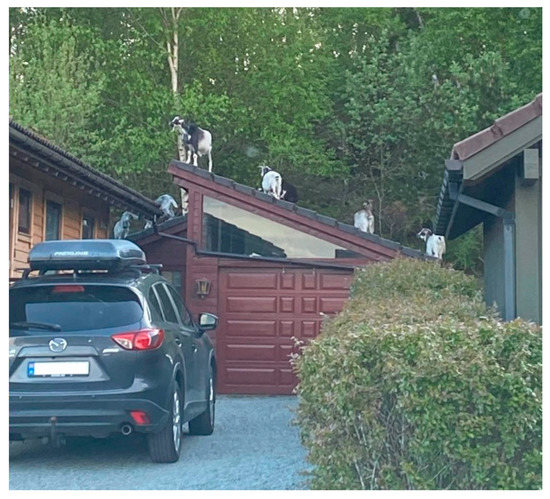
Figure 6.
Goats on a private garage. Photo by Ann Elin Ulland. Reproduced with permission.
An app showing collars within 20 km of the spectator’s location was shared through social media and written material so that the public could easily locate the goats; see Figure 7a. The researchers often observed people paying the goats a visit. They behaved quietly and politely when close to the goats, who did not reveal any stress when visited. Frequent visitors were indeed physically welcomed by the goats.
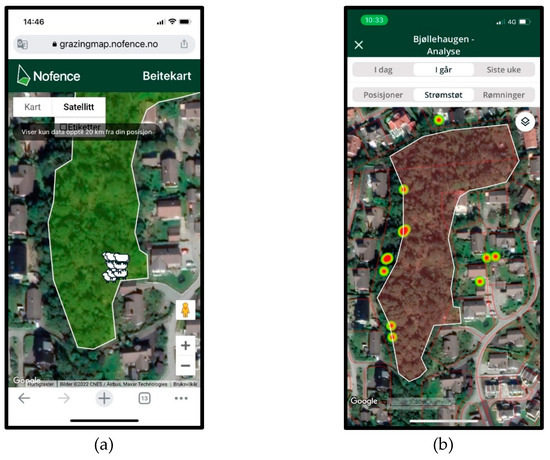
Figure 7.
Screen shot of the open app (https://grazingmap.nofence.no/, accessed on 1 September 2022) for locating grazing animals, May 20 (a) and positions of modest electrical shocks marked on the map for June 11 (b).
During the seventh week, the goats had consumed the easily accessible food from deciduous trees, etc. Figure 7b shows that some goats stretched the limits quite far until they received shocks, fortunately without creating too much havoc. The app notified the researchers each time a goat received a shock, as well as stagnant and escaped goats (collars), etc. A circle on the app indicated the GPS position uncertainty of each collar. The many trees influenced the GPS signals and led to unnecessary sound signals and increased power consumption. Thus, tall trees and buildings may make that borders fuzzy and thus, possibly confuse the goats. Due to the trees making shadow, and the goats often resting in shade, the photovoltaic charging did not keep up with the electricity consumption even on quite sunny days. Generally, the batteries lasted 8–15 days. Thus, topped-up batteries always had to be available.
The overall experience with the Nofence system was convincing. It allowed for interesting analyses of the whereabout of the goats as heat maps, etc. The goats produced some, but not much havoc, and once the researchers had gained experience with the system, the havoc was minimized. Thus, yes must be the answer to the first research question, i.e., the system did prevent the goats from creating too much havoc in neighboring gardens.
3.2. Evidence of Juniper Grazing
All conspicuous junipers in the northern 0.6 ha were photographed prior to and after grazing. These 110 junipers were photographed less than three days prior to the grazing and less than two days after the eight-week grazing period. The photos were taken under different light and background conditions. Typical background prior to grazing was pine trunks, cured grass and leafless deciduous branches while pine trunks, green grass and deciduous leaves represented the background eight weeks later. The photographic evidence was supported by field trips to evaluate an approximate reduction in live juniper foliage.
Generally, the junipers’ foliage was either fairly untouched or fairly eaten by the goats. It was therefore decided to sort the grazed junipers into four categories, i.e., either <10%, 10–50%, 50%–90% or >90% remaining green foliage. Figure 8, Figure 9, Figure 10 and Figure 11 show representative photos of junipers in these categories.
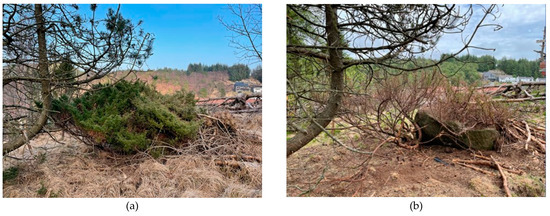
Figure 8.
A juniper prior to grazing (a) with less than 10% remaining live foliage after grazing (b).

Figure 9.
A juniper prior to grazing (a) with 10% to 50% remaining live foliage after grazing (b).
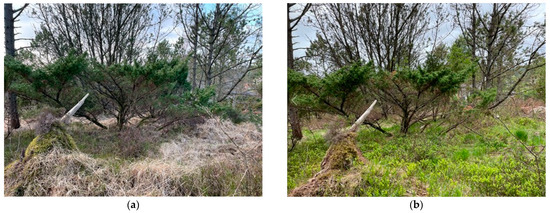
Figure 10.
A juniper prior to grazing (a) with 50% to 90% remaining live foliage after grazing (b).
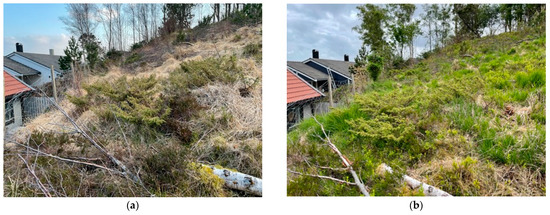
Figure 11.
A juniper prior to grazing (a) with more than 90% remaining live foliage after grazing (b).
There were also examples where junipers close to each other experienced highly different grazing levels. Figure 12 shows three junipers where two of them were nearly completely grazed while the one in the middle had about 20% live foliage remaining. An example of a juniper requiring careful attention before categorization is shown in Figure 13.

Figure 12.
Three junipers (far left, middle and right) prior to grazing (a) with respectively <10%, 10–50% and <10% remaining live foliage after grazing (b). The untouched plant in the left part of the pictures is a non-native garden plant.
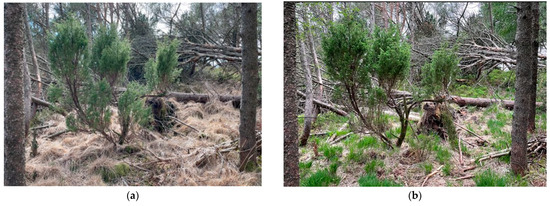
Figure 13.
One of the junipers (a) requiring detailed field analysis for deciding the grazing level to slightly more than 90% remaining live foliage after grazing (b).
The number and fraction of junipers in each of the four categories after grazing are presented in Table 1. Based on three decades of teaching and research in fire dynamics, and a decade of participation in prescribed burning (PB) and teaching on PB courses, the senior researcher evaluated the possible fire behavior of these four foliage categories. It was evaluated that a juniper with < 10% remaining live foliage would be far less fire-prone than the same juniper with untouched foliage. Even junipers in the next category, i.e., with 10–50% remaining foliage, would burn much less vigorously than the same juniper with all foliage intact, and thus represent a significantly reduced fire danger. It was, however, evaluated that junipers with more than 90% remaining foliage would burn quite comparable to an untouched juniper. This conclusion was supported by the other researchers, who are involved in research on heathland fire emergency management and had participated in 10+ PB courses and PB sessions during the last two years.

Table 1.
Distribution of the 110 junipers in the remaining foliage categories after grazing.
Since 41% of the junipers had little remaining foliage, and another 11% had less than 50% remaining foliage, the grazing had a great impact on the junipers, i.e., the goats certainly consumed fire-prone juniper foliage to an extent that it had a safety impact. Therefore, yes must be the answer to the second research question.
3.3. Evidence of Spruce and Fir Grazing
The number of small spruces was significantly lower than the number of junipers, and since they burn less vigorously than the oil-containing junipers, they did not receive that much focus in the present study. The goats’ appetite for young spruces was, however, easy to observe in the field; see Figure 14.
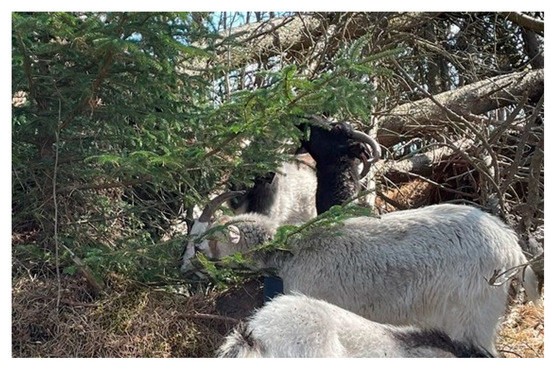
Figure 14.
Though deciduous trees were the most popular feeder for the goats, young spruces were also a popular part of their varied diet.
However, some spruces were regardless photographed, in case they could provide interesting information. When analyzing the photos of junipers, even more spruces could be evaluated regarding the grazing effect. Of 10 identified small, i.e., less than 1 m tall spruces, all had less than 10% live foliage remaining after the grazing period. An example is given in Figure 15. For taller spruces, foliage at accessible heights had in general been much reduced. The impact on these could, however, not be quantified.
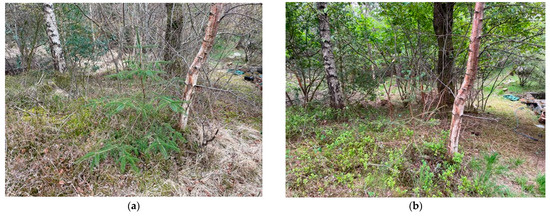
Figure 15.
A representative young spruce prior to grazing (a) with less than 10% remaining live foliage after grazing (b).
By the end of week 7, most deciduous trees, except birches, had been debarked and the goats had eaten deciduous foliage within reach by stretching or bending trees. During this period, goats were also observed debarking young pines, as can be seen in Figure 16.
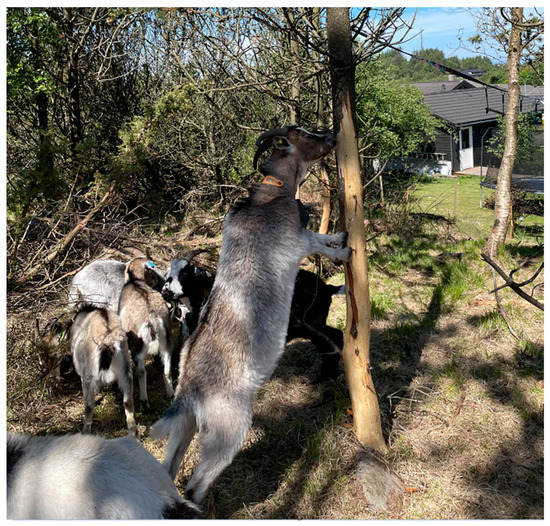
Figure 16.
By week 7, the bark of pine trees was also to some extent consumed.
3.4. Cured Grass
Cured grass may spread fire fast in coastal Norway during winter- and springtime. Where not grazed, this fluffy and easily ignitable fuel covers vast areas. However, as can be seen from, e.g., Figure 8, Figure 9, Figure 10, Figure 11, Figure 12 and Figure 13, the goats compacted the cured grass and thus made it less fire-prone and increasingly prone to putrefaction. Early in the grazing period, they were also observed eating some cured grass. Thus, the goats reduced the fire danger also by trampling on, and partly eating, cured grass.
Since both cured grass and junipers influence the fire danger in coastal Norway, grazing in other seasons should be considered. Grazing in the fall would limit the amount of cured grass during the winter and thereby contribute to the reduction in fire danger.
3.5. Weight Development of the Goats during the Grazing Period
The goats were also weighed one day after the grazing period; see Table A1. All the goats had gained weight, as can be seen in Figure 17. The relative weight gain was generally larger for the lighter goats.
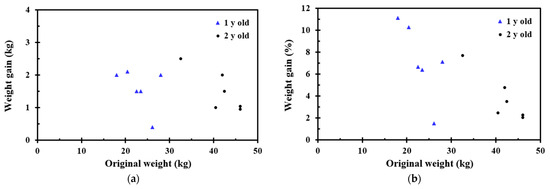
Figure 17.
Weight gain (a) and relative weight gain (b) as a function of the weight prior to grazing.
3.6. Results from Interviewing the Neighbors
The owners with villas bordering the grazing area were contacted during the week following the grazing period for possible interviews. Fifteen of these owners, and often their spouses too, were available for interviews.
The majority of the interviewees expressed a need for managing the site bordering their property. Some expressed a worry regarding fire safety. One owner had independently contacted the municipality to ask for their engagement in reducing fire-prone biomass close to the homes. The municipality could, however, not intervene on the privately owned site. Others considered the fire risk as low based on no observed fires at the site during the past 30–40 years. Eight interviewees had become more aware of possible WUI fire risk and valued the grazing as positive in this respect. Several had hoped for even more biomass reduction during the grazing period.
Half the interviewees had seen the goats quite regularly, while a handful had seen them only a few times. Some residents became so familiar with the goats that they were physically welcomed when approaching the herd.
Residents who had lost some garden plants to the goats, or had to chase goats down from their roofs, advised to ensure more border margins for future virtually fenced grazing. Independently of each other, they suggested to rather start with more margins to gardens, and if that worked well, then gradually to extend the borders.
The interviewees were split regarding the goats’ hunger for deciduous trees. They generally commented on the need to keep the encroachment under control, but some of them did not like large trees being debarked to the extent that they would eventually die and had to be cut and removed. It was also commented that large trees consume a lot of water, and thereby contribute to keeping the soil and lawns dry in the generally humid climate. Therefore, trees close to the garden were in some cases wanted. To protect stems on selected deciduous trees could be worthwhile when considering future grazing projects.
Four interviewees commented on the lack of deer in the area during the grazing period. Since deer graze everywhere, it was concluded by these interviewees that they had generally experienced less loss of garden plants to deer. One of them expressed it in this way: “I will probably keep more of my apples this year”. Thus, the effect of keeping deer away was a positive experience not previously anticipated by the researchers. Five interviewees also commented on ticks that they believed came with the deer and represent a local challenge for people and pets. They considered that goats keeping the deer away could help reducing the tick population.
All interviewees were positive, and some even enthusiastic, about the goats grazing in the neighboring site at Bjøllehaugen, including villa owners who experienced goats climbing buildings or loss of garden plants, e.g., roses, tulips and/or raspberry bushes. All expressed the view that it was cozy to watch the goats and to visit them in the field.
Ten of the interviewees had hoped that the goats could stay longer and asked for their return on a later occasion. Six of them expressed the opinion that they really missed the goats who, according to them, “gave life to the forest”. These eight weeks, the piece of land was “not only a forest”, i.e., they expressed that “something happened there”. It was a positive attribute to have goats in the vicinity as entertainment in an otherwise quiet neighborhood. These interviewees wanted the goats back—if possible.
When asked about possible future grazing, none of the interviewees was against a repeated grazing period on another occasion. Several of them called for the goats to come back in the fall to eat the grass that would otherwise die and result in a subsequent cured grass fire risk. This was outside the scope of the study, but could be very valuable for future WUI fire risk mitigation studies. The timing of the grazing with limited sprouts in the start may have contributed to the goats’ appetite for evergreens such as junipers and conifers.
It may be concluded that the goat grazing initiative as such was well received by the villa owners sharing a border with the grazing area. Complying with the improvements suggested by the interviewees, future grazing projects could become even more successfully evaluated by the public and result in further WUI fire fuel removal.
Several of the interviewees commented on the concept of potential WUI fire fuel ending up as food for goats, thereby producing local meat. The sustainability value of this nature-based local food production approach was much appreciated.
To the third research question, i.e., regarding how the adjacent owners responds to/perceives virtually fenced goats in their neighborhood, the answer turned out to be that the goats were generally well accepted. That all interviewees were positive to a new grazing period is inspiring regarding “herds of goats” as WUI fire risk mitigators [32].
4. Discussion
The decision to try goats for reducing the fire-prone biomass in the WUI was inspired by research elsewhere [1,2,3,4,5,6,7,8,49,50,51], as well as studies of the Sotra fire, Norway, June 2021 [28,32]. In the previously Calluna-dominated heathland, for millennia grazing, and prescribed burning limited biomass accumulation. When unmanaged as it is today, juniper encroaches the moorland. Goats graze some juniper, and to assess grazing close to homes in Western Norway seemed interesting. In view of preconditioning and heritability for improved Juniperus pinchotii and Juniperus asheii consumption of goats in the USA [52,53], goat grazing may represent a way to manage the fire-prone biomass accumulation.
Goats are known to create havoc in private gardens if not restricted by, e.g., physical fences. Taking advantage of a recently developed Nofence virtual fencing technology [39,40,41,42] could represent borders for the goats, i.e., a key enabler for the present study.
The researchers had no previous experience with virtual fencing but were eager to test it due to its potential. Some beginner errors were inevitable. These errors were, however, eliminated as experience was gained. The researchers were used to dogs, and it was beneficial that one of the researchers grew up on, and had worked on, a farm with herds of sheep and cattle. Within about two weeks, the researchers felt quite comfortable with the Nofence technology, replacing batteries when required, etc. This was about the same time it took for the goats to become familiar with the researchers, and vice versa.
Initially, some virtual borders were set too optimistically. This was easily adjusted during the project since the goat owner gave full access to the password-protected Nofence app. To start with conservative borders, as suggested by some interviewees, and then move the borders closer to neighboring gardens, would be beneficial in future applications. Regarding research question one, the Nofence system certainly worked well for maintaining borders for goat grazing adjacent to the homes, i.e., it prevented the goats from creating too much havoc in neighboring properties.
To achieve an impact within eight weeks, the grazing project was carried out with 12 goats, six one-year-olds and six two-year-olds. It might be better, and it is recommended, to start with fewer goats, e.g., five to eight goats, to gain experience with the animals, the collars, the batteries and with the Nofence technology prior to any upscaling.
Since juniper encroachment in previously Calluna-dominated heathland represents an increasing wildfire risk in the coastal Norway WUI [28,32], these plants were focused. Some 110 junipers were photographed prior to and after grazing. Of these, 41% were grazed to less than 10%, and most of them to practically no, live foliage. Another 11% were grazed to less than 50% remaining foliage. The precision in the analysis of foliage consumption was not high. It may, however, still be concluded that the combustibility of about half the analyzed junipers was significantly reduced. The goats, which were not selected by food preferences, made a significant impact on the junipers, in line with studies of shrub grazing, e.g., in Spain [54]. They were also observed eating cured grass and trampled the fluffy cured grass quite flat, i.e., making an additional contribution regarding fire hazard reduction.
Grazing on spruces was only documented for a few trees, in addition to ”lens lice” spruces on juniper photos. The goats did, however, have a significant impact on reducing live foliage on these young spruces. Reducing live juniper and spruce foliage considerably, and making the cured grass less fire-prone, the goats significantly affected the fire danger of the grazed area. Thus, yes must be the answer to research question two regarding goat grazing affecting junipers and other low-height fire-prone vegetation.
Due to size, topography, vegetation cover, etc. the selected site was not very fire-prone compared to areas previously struck by fires in Norway [28,30,31,32]. It was, however, convenient that the Bjøllehaugen Neighborhood Federation (BNF) had planned to improve paths by removing shrubs and trees, place benches at viewpoints, etc. Moreover, the site contained enough junipers to evaluate whether grazing would make a difference. However, as the BNF had already mentioned encroachment as an issue, the neighbors may have been primed for measures to be taken at the site. This may have influenced them positively also regarding goat grazing. It cannot be ruled out that they might have been more reluctant, at least in the early phase, without the BNF’s previous engagement. This may be taken as a learning point regarding future grazing projects close to villas, i.e., to search for neighborhood federations that support, and thus can help pave the road for, such initiatives. Moreover, including the residents in the decision-making process may reduce tension and conflict by facilitating sufficient borders, protecting selected plants and trees at the site and in adjacent gardens [38]. One interviewee expressed the view that being invited by the BNF during the decision-making process, would have been much appreciated.
The positive attitude to goat grazing shown by all interviewees, including those who experienced some havoc in their gardens, indicates that the goats were welcome at Bjøllehaugen. It is likely that the same could be concluded elsewhere in previously Calluna-dominated Norwegian heathlands. The goats created “‘life” in an otherwise quiet neighborhood and many neighbors visited them. That school classes and kindergartens visited the goats, guided by local kids who had previously visited them, also indicated that the goats were much appreciated. There were also several other benefits related to the goats that had not been envisaged, e.g., fewer or no deer rampaging near the gardens.
The owners not interviewed were either travelling or working shifts, etc. and were thus unavailable. It is likely that they had similar opinions about the goat grazing as those interviewed. There have not been any complaints suggesting otherwise, either to the researchers or to the BNF. Thus, the answer to the third research question regarding how the locals responded to/perceived goats for fire fuel reduction in their neighborhood is that the goats were appreciated. All interviewees welcomed them back for another grazing period and several expressed the view that they missed the goats. It should be noted that the open-ended question approach used for the interviews may have left some room for interpretation by the researchers, i.e., possible bias. In future studies it may be worthwhile considering other methods, such as Likert-scale questionnaires to gain more quantitative results. The questions may then be developed based on the current study findings to test these findings in more sites, as well as in more fire-prone regions.
Due to the success of the project, the goat owner offered to let the goats graze for free for another week or two. However, since the researchers needed to travel abroad, the goats had to be collected by the owner after eight weeks.
To this point, it has not been discussed how the researchers reacted after the goats had been dismissed. In line with the neighbors, the researchers also missed the goats. Locally, there have been discussions regarding establishing a small herd permanently at Bjøllehaugen and in its vicinity for grazing fire-prone biomass, possibly in cooperation with other neighborhood federations. Keeping goats year-round in Norway would require a simple shed for adverse weather conditions. Whether that becomes a reality in the future is uncertain. However, 2 km north of Bjøllehaugen three families have already bought six goats using Nofence virtual fencing in their neighborhood [55] to keep the landscape open and for the kids to become familiarized with the animals; see Figure 18. This shows that it is possible to facilitate virtually fenced goat grazing through a bottom-up approach.
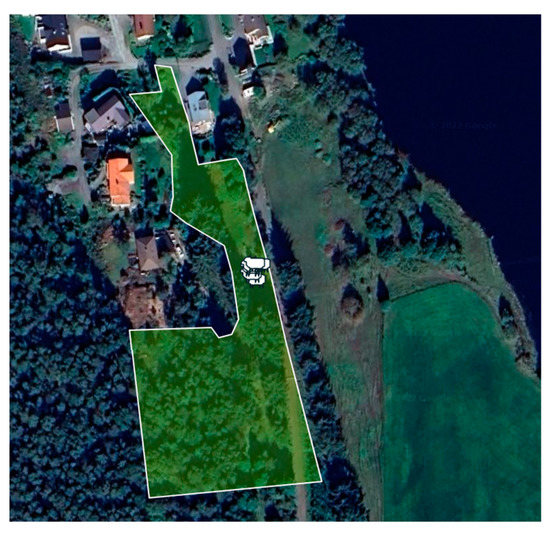
Figure 18.
A private initiative involving six goats grazing 2 km north of the Bjøllehaugen test site.
A study in Alaska revealed that when neighbors mobilized for fire fuel removal, the likelihood of other owners joining the initiative increased [56]. This may likely also be the case in Norway, and it will be interesting to see whether private or neighborhood federation initiatives will also be initiated elsewhere.
The interviewees had several suggestions for improvements which are recommended for future studies. Preconditioning goats for consuming more Juniper communis, as has been done with other junipers in the USA [52,53], and been shown not to adversely affect meat quality [57], may be a good suggestion for improved juniper grazing. Just making juniper branches with green foliage available may be sufficient for the preconditioning during weaning. It should, however, be kept in mind that juniper contains monoterpenoids that may cause aversive postingestive feedback [52,53], i.e., other forages must also be richly available.
Grazing in the fall should be considered as that would reduce the amount of cured grass considerably during winter and spring. Old Norse (ON) sheep also graze some juniper in addition to grass and winter green Calluna [58]. Thus, it is recommended to consider ON sheep as they may leave large deciduous tree stems untouched while consuming more grass. Further research on goat and/or sheep grazing may help to reduce the ever-increasing WUI fire risk in coastal Norway and make wildfires easier to manage [59].
The living lab approach [43] allowed for valuable adjustments during the study, e.g., when trying to feed the goats juniper foliage and learning that they hijacked juniper branches. The tall deciduous trees being debarked will later need to be cut, e.g., for firewood. In future projects, it may be worthwhile cutting such trees while the goats are still present. They could then enjoy eating the bark, thin branches and foliage, making the final cleanup easier, and resemble a closer-knit animal–human living-lab cooperation.
The social stigma cattlemen attached to goats 20+ years ago, then recognized as the foremost limitation regarding goats for brush and weed control in the USA [60], does not seem to be a challenge in Norway today. However, economic support to reduce the fire risk is with a few exceptions, e.g., fire protection of rural historic buildings, absent in Norway. Land management, especially regarding class A Calluna-dominated heathlands, receives support through special Norwegian agricultural sector environment initiatives [61]. There is, however, no support for initiatives in the general WUI, despite a very favorable cost-benefit ratio of support to land management versus costs associated with firefighting [33]. In other sectors, e.g., fire protection of heritage buildings, just developing municipal plans made a big difference to fire frequency and consequences [62]. The present study has demonstrated that the virtual fencing works for goat grazing in the WUI, that they consumed fire-prone biomass, and that the community enjoyed the grazing goats. Thus, the study may be used to advertise the many benefits of goat grazing in addition to improved fire safety. Hopefully, this may result in improved funding, or at least, in municipal plans supporting grazing. Compared to, e.g., the USA, where prescribed burning was carried out by Indigenous people, and thus difficult to get started again [63], this landscape management was carried out by the great-grandparent generation in coastal Norway. Research to identify the obstructions regarding support for landscape management in the WUI by grazing and/or prescribed burning where possible, should be undertaken also considering the other benefits highlighted by the interviewees, e.g., local food production, “life in the forest”, fewer ticks, etc.
While several studies have involved WUI biomass reduction and the impact of goats grazing fire-prone biomass [36,64,65,66,67], these studies were not performed along the borders of private homes. The novelty of the present study is related to the proximity of grazing to private homes, virtual fences as grazing borders and feedback from the homeowners, i.e., a necessity when grazing the extended defensible space.
Virtually fenced goat grazing represents a promising sustainable solution [4] for reducing juniper encroachment and can be repeated or extended as required. The wildfire risk is generally much higher in warmer climates with a higher water vapor pressure deficit [68]. Much effort has been taken elsewhere to reduce the fire-prone biomass, especially close to homes [4,7,28,50,51,60,69]. After biomass reduction by manpower, as achieved, e.g., in Kithira, Greece [49], where grazing was not part of the study, virtually fenced goats could possibly control the regrowth in a sustainable way while providing local meat or dairy products. In sunny regions, or areas with fewer tall trees than at Bjøllehaugen, there is less need for manual intervention regarding, e.g., battery changes. While using Nofence for Limousin cows grazing at pasture in Italy, there was indeed no need for battery changes [42]. The present study may have a bearing also on more fire-prone regions than coastal Norway and help to develop fire-adapted communities [37,70]. Given the other benefits revealed in the present study, this may probably be achieved without destructive wildfires having provided “hot moments” triggering community adaptation [71].
5. Conclusions
The present study has demonstrated that virtual fencing can be used for goat grazing fire-prone biomass in the coastal Norway WUI. Except for a few minor initial incidents, the Nofence system kept the goats from raiding neighboring gardens. Live foliage of half the junipers was considerably reduced during eight weeks’ grazing. The goats also had an impact on cured grass and young spruces. The interviews revealed that the owners of villas bordering the site were positive about the goat grazing. The goats created entertainment and “life in the forest” and the residents wanted them back again, if possible. This is inspiring regarding possible upscaling in Norway, and elsewhere.
Author Contributions
Conceptualization, T.L., M.-M.M.; methodology, M.-M.M., A.M.G., T.L.; validation, T.L.; formal analysis, A.M.G., T.L.; field work, A.M.G., T.L.; investigation, T.L., M.-M.M.; resources, M.-M.M.; data curation, T.L.; writing—original draft preparation, T.L.; writing—review and editing, M.-M.M., A.M.G., T.L.; visualization, T.L.; supervision, M.-M.M.; project administration, M.-M.M.; funding acquisition, M.-M.M. All authors have read and agreed to the published version of the manuscript.
Funding
This research was funded by the Research Council of Norway (RCN), grant number 298993 (DYNAMIC) together with, Fagne, Stavanger municipality and the Norwegian Directorate of Cultural Heritage and RCN grant number 301569 (BUILDER). The APC was covered by MDPI.
Institutional Review Board Statement
The study was approved by the Norwegian Centre for Research Data, number 117797, 3 May 2022.
Informed Consent Statement
Informed consent was obtained from all subjects involved in the study.
Acknowledgments
The cooperation of the Bjøllehaugen Neighborhood Federation is highly appreciated. Assistance from Terje Kleiven in recording the weights of the goats is also highly appreciated. The anonymous reviewers’ suggestions for improving the manuscript are highly appreciated.
Conflicts of Interest
The authors declare no conflict of interest. The funders had no role in the design of the study; in the collection, analyses, or interpretation of data; in the writing of the manuscript; or in the decision to publish the results.
Appendix A
The goats were weighed just prior to the 1 h transport to the Bjøllehaugen test site. They were also weighed one day after the grazing period was completed. The recorded weight data are presented in Table A1. The weight gains for the 2-year-old and the 1-year-old goats were in average 1.5 kg ±0.6 kg and 1.6 kg ± 0.6 kg, respectively.

Table A1.
The individual weight of each goat recoded the same day as the 1 h transport to the Bjøllehaugen test site and one day after the grazing period at Bjøllehaugen.
Table A1.
The individual weight of each goat recoded the same day as the 1 h transport to the Bjøllehaugen test site and one day after the grazing period at Bjøllehaugen.
| Goat Number | Age (Year) | Weight (Before) (kg) | Weight (After) (kg) |
|---|---|---|---|
| 01002 | 2 | 46.0 | 47.0 |
| 01024 | 2 | 46.0 | 47.0 |
| 01031 | 2 | 42.0 | 44.0 |
| 01032 | 2 | 42.5 | 44.5 |
| 01037 | 2 | 32.5 | 35.0 |
| 01042 | 2 | 40.5 | 41.5 |
| 11022 | 1 | 18.0 | 20.0 |
| 11040 | 1 | 23.5 | 25.0 |
| 11041 | 1 | 22.5 | 24.0 |
| 11042 | 1 | 28.0 | 30.0 |
| 11055 | 1 | 26.1 | 26.5 |
| 11073 | 1 | 20.4 | 22.5 |
References
- Doerr, S.H.; Santín, C. Global trends in wildfire and its impacts: Perceptions versus realities in a changing world. Phil. Trans. R. Soc. B 2016, 371, 20150345. [Google Scholar] [CrossRef] [PubMed]
- Bento-Gonçalves, A.; Vieira, A. Wildfires in the wildland-urban interface: Key concepts and evaluation methodologies. Sci. Total Environ. 2019, 707, 135529. [Google Scholar] [CrossRef] [PubMed]
- Badia, A.; Pallares-Barbera, M.; Valldeperas, N.; Gisbert, M. Wildfires in the wildland-urban interface in Catalonia: Vulnerability analysis based on land use and land cover change. Sci. Total Environ. 2019, 673, 184–196. [Google Scholar] [CrossRef] [PubMed]
- Log, T.; Vandvik, V.; Velle, L.G.; Metallinou, M.-M. Reducing Wooden Structure and Wildland-Urban Interface Fire Disaster Risk through Dynamic Risk Assessment and Management. Appl. Syst. Innov. 2020, 3, 16. [Google Scholar] [CrossRef]
- Reddet Fra Flammene:—Det var et Skikkelig Inferno (Rescued from the Flames:—It Was a Real Inferno). Available online: https://www.vg.no/nyheter/innenriks/i/vQldqV (accessed on 6 August 2022).
- How Climate Change Is Causing ‘Mega-Fires’ and Forcing People to Migrate in Portugal. Available online: https://www.euronews.com/2020/06/17/how-climate-change-is-causing-mega-fires-and-forcing-people-to-migrate-in-portugal (accessed on 5 August 2022).
- Rego, F.M.C.C.; Rodríguez, J.M.M.; Calzada, V.R.V.; Xanthopoulos, G. Forest Fires—Sparking Firesmart Policies in the EU; Publications Office of the European Union: Luxembourg, 2018; p. 53. ISBN 978-92-79-77493-5. [Google Scholar] [CrossRef]
- Mowery, M.; Read, M.; Johnston, K.; Wafaie, T. Planning the Wildland-Urban Interface; Report 594, Planning Advisory Service; American Planning Association: Washington, DC, USA, 2019; ISBN 978-1-61190-202-0. [Google Scholar]
- Carreiras, M.; Ferreira, A.J.D.; Valente, S.; Fleskens, L.; Gonzales-Pelayo, O.; Rubio, J.L.; Stoof, C.R.; Coehlo, C.O.A.; Ferreira, C.S.; Ritsema, C.J. Comparative analysis of policies to deal with wildfire risk. Land Degrad. Dev. 2014, 25, 92–103. [Google Scholar] [CrossRef]
- Montiel-Molina, C. Comparative assessment of wildland fire legislation and policies in the EU: Towards a fire framework directive. For. Policy Econ. 2013, 29, 1–6. [Google Scholar] [CrossRef]
- Carle, D.; Kaufmann, J. Burning Questions: America’s Fight with Nature’s Fire; Greenwood Publishing Group: Westport, CT, USA, 2002; ISBN 0-275-97371-9. [Google Scholar]
- Metallinou, M.-M. Emergence of and Learning Processes in a Civic Group Resuming Prescribed Burning in Norway. Sustainability 2020, 12, 5668. [Google Scholar] [CrossRef]
- Borghesio, L. Can fire avoid massive and rapid habitat change in Italian heathlands? J. Nat. Conserv. 2014, 22, 68–74. [Google Scholar] [CrossRef]
- Baeza, M.J.; De Luís, M.; Raventós, J.; Escarré, A. Factors influencing fire behavior in shrublands of different stand ages and the implications for using prescribed burning to reduce wildfire risk. J. Environ. Manag. 2002, 65, 199–208. [Google Scholar] [CrossRef]
- Roos, C.I.; Swetnam, T.W.; Ferguson, T.J.; Liebmann, M.J.; Loehman, R.A.; Welch, J.R.; Margolis, E.Q.; Guiterman, C.H.; Hockaday, W.C.; Kiahtipes, C.A.; et al. Native American fire management at an ancient wildland–urban interface in the Southwest United States. Proc. Natl. Acad. Sci. USA 2021, 118, e2018733118. [Google Scholar] [CrossRef]
- Kaland, P.E. The origin and management of Norwegian coastal heaths as reflected by pollen analysis. In Anthropogenic Indicators in Pollen Diagrams; Behre, K.E., Ed.; Balkema: Rotterdam, The Netherlands, 1986; pp. 19–36. [Google Scholar]
- Keeley, J.E. Native American impacts on fire regimes of the California coastal ranges. J. Biogeogr. 2002, 29, 303–320. [Google Scholar] [CrossRef]
- Bowman, D.M.J.S. The impact of Aboriginal landscape burning on the Australian biota. New Phytol. 1998, 140, 385–410. [Google Scholar] [CrossRef] [PubMed]
- Gimingham, C.H. The Lowland Heathland Management Handbook; English Nature: Peterborough, UK, 1992; ISBN 1 85716 0770. [Google Scholar]
- Cucu, A.-A.; Baci, G.-M.; Cucu, A.-B.; Dezsi, Ş.; Lujerdean, C.; Hegeduş, I.C.; Bobiş, O.; Moise, A.R.; Dezmirean, D.S. Calluna vulgaris as a Valuable Source of Bioactive Compounds: Exploring Its Phytochemical Profile, Biological Activities and Apitherapeutic Potential. Plants 2022, 11, 1993. [Google Scholar] [CrossRef] [PubMed]
- Vandvik, V.; Töpper, J.P.; Cook, Z.; Daws, M.I.; Heegaard, E.; Måren, I.E.; Velle, L.G. Management-driven evolution in a domesticated ecosystem. Biol. Lett. 2014, 10, 20131082. [Google Scholar] [CrossRef] [PubMed]
- Velle, L.G.; Nilsen, L.S.; Vandvik, V. The age of Calluna stands moderates post-fire regeneration rate and trends in northern Calluna heathlands. Appl. Veg. Sci. 2012, 15, 119–128. [Google Scholar] [CrossRef]
- Miljostatus Kystlynghei (The Environmental Condition of Calluna Heathlands). Available online: https://miljostatus.miljodirektoratet.no/kystlyngheiKaland (accessed on 30 October 2020).
- Kaland, P.-E.; Kvamme, M. Kystsyngheiene i Norge–Kunnskapsstatus og Beskrivelse av 23 Referanseområder (The Coastal Calluna Heathlands in Norway—Knowledge Status and Description of 23 Areas of Reference); Miljødirektoratet: Oslo, Norway, 2013. [Google Scholar]
- Hauglin, M.; Ørka, H.O. Discriminating between Native Norway Spruce and Invasive Sitka Spruce—A Comparison of Multitemporal Landsat 8 Imagery, Aerial Images and Airborne Laser Scanner Data. Remote Sens. 2016, 8, 363. [Google Scholar] [CrossRef]
- Nygaard, P.H.; Øyen, B.-H. Spread of the Introduced Sitka Spruce (Picea sitchensis) in Coastal Norway. Forests 2017, 8, 24. [Google Scholar] [CrossRef]
- Zheljazkov, V.D.; Astatkie, T.; Jeliazkova, E.A.; Heidel, B.; Ciampa, L. Essential Oil Content, Composition and Bioactivity of Juniper Species in Wyoming, United States. Nat. Prod. Commun. 2017, 12, 201–204. [Google Scholar] [CrossRef]
- Log, T.; Gjedrem, A.M. A Fire Revealing Coastal Norway’s Wildland–Urban Interface Challenges and Possible Low-Cost Sustainable Solutions. Int. J. Environ. Res. Public Health 2022, 19, 3038. [Google Scholar] [CrossRef]
- Log, T. Modeling Drying of Degenerated Calluna vulgaris for Wildfire and Prescribed Burning Risk Assessment. Forests 2020, 11, 759. [Google Scholar] [CrossRef]
- DSB. Brannene i Lærdal, Flatanger og på Frøya Vinteren 2014 (The Fires in Lærdal, Flatanger and on Frøya Winter 2014); Norwegian Directorate for Civil Protection: Tønsberg, Norway, 2014; ISBN 978-82-7768-342-3. [Google Scholar]
- Log, T.; Thuestad, G.; Velle, L.G.; Khattri, S.K.; Kleppe, G. Unmanaged heathland—A fire risk in subzero temperatures? Fire Saf. J. 2017, 90, 62–71. [Google Scholar] [CrossRef]
- Øygarden brann og redning. Lyng- og Utmarksbrann 3.- 13. Juni 2021, Sotra, Øygarden Kommune. (Heather and Wildland Fire 3–13 June 2021, Sotra, Øygarden Municipality); Øygarden municipality: Straume, Norway, 2021; p. 37. (In Norwegian) [Google Scholar]
- Halvorsen, B.; Grimsrud, K. Brannfare i Norske Kystlyngheier—Statistisk Analyse av Risikofaktorer og Nytte-Kostnadsanalyse av Tiltak (Fire Hazards in Norwegian Coastal Heaths—Statistical Analysis of Risk Factors and Benefit-Cost Analysis of Measures); Statistics Norway: Oslo, Norway, 2021; p. 66. ISBN 978-82-587-1357-6. (In Norwegian) [Google Scholar]
- Lillemo, S.C.; Halvorsen, B. The impact of lifestyle and attitudes on residential firewood demand in Norway. Biomass Bioenergy 2013, 57, 13–21. [Google Scholar] [CrossRef]
- Skreiberg, O.; Seljeskog, M. Performance history and further improvement potential for wood stoves. Chem. Eng. Trans. 2018, 65, 199–204. [Google Scholar] [CrossRef]
- Lovreglio, R.; Meddour-Sahar, Q.; Leone, V. Goat grazing as a wildfire prevention tool: A basic review. iForest 2014, 7, 260–268. [Google Scholar] [CrossRef]
- Paveglio, T.B.; Abrams, J.; Ellison, A. Developing fire adapted communities: The importance of interactions among elements of local context. Soc. Nat. Res. 2016, 29, 1246–1261. [Google Scholar] [CrossRef]
- Simon, C.; Mobekk, H. Dugnad: A Fact and a Narrative of Norwegian Prosocial Behavior. Perspect. Behav. Sci. 2019, 42, 815–834. [Google Scholar] [CrossRef]
- Søraa, R.A.; Vik, J. Boundaryless boundary-objects: Digital fencing of the CyborGoat in rural Norway. J. Rural. Stud. 2021, 87, 23–31. [Google Scholar] [CrossRef]
- Vik, J.; Melås, A.M.; Stræte, E.P.; Søraa, R.A. Balanced readiness level assessment (BRLa): A tool for exploring new and emerging technologies. Techn. Forecast. Soc. Chang. 2021, 169, 120854. [Google Scholar] [CrossRef]
- Aaser, M.F.; Staahltoft, S.K.; Korsgaard, A.H.; Trige-Esbensen, A.; Alstrup, A.K.O.; Sonne, C.; Pertoldi, C.; Bruhn, D.; Frikke, J.; Linder, A.C. Is Virtual Fencing an Effective Way of Enclosing Cattle? Personality, Herd Behaviour and Welfare. Animals 2022, 12, 842. [Google Scholar] [CrossRef]
- Confessore, A.; Aquilani, C.; Nannucci, L.; Fabbri, M.C.; Accorsi, P.A.; Dibari, C.; Argenti, G.; Pugliese, C. Application of Virtual Fencing for the management of Limousin cows at pasture. Livestock Sci. 2022, 263, 105037. [Google Scholar] [CrossRef]
- Dell’Era, C.; Landoni, P. Living Lab: A Methodology between User-Centred Design and participatory design. Create. Innov. Manag. 2014, 23, 137–154. [Google Scholar] [CrossRef]
- Ballon, P.; Van Hoed, M.; Schuurman, D. The Effectiveness of Involving Users in Digital Innovation: Measuring the mpact of Living Labs. Telemat. Inform. 2018, 35, 1201–1214. [Google Scholar] [CrossRef]
- van den Kieboom, R.C.P.; Bongers, I.M.B.; Mark, R.E.; Snaphaan, L.J.A.E. User-driven Living Lab for Assistive Technology to Support People with Dementia Living at Home: Protocol for developing cocreation-based innovations. JMIR Res. Protoc. 2019, 8, e10952. [Google Scholar] [CrossRef] [PubMed]
- Bjøllehaugen Velforening Informasjonsskriv (Bjøllehaugen Neighborhood Federation Information Letter). March 2022. (In Norwegian)
- Gillham, B. Research Interviews, The Range of Techniques; McGraw-Hill Education: London, UK, 2005; ISBN 978-0335215867. [Google Scholar]
- Kvale, S. Interviews. An Introduction to Qualitative Research Inter-Viewing, 2nd ed.; Sage Publications: Thousand Oaks, CA, USA, 2004; ISBN 978-0803958203. [Google Scholar]
- Xanthopoulos, G.; Athanasiou, M.; Nikiforaki, A.; Kaoukis, K.; Mantakas, G.; Xanthopoulos, P.; Papoutsakis, C.; Christopoulou, A.; Sofronas, S.; Gletsos, M.; et al. Innovative Action for Forest Fire Prevention in Kythira Island, Greece, through Mobilization and Cooperation of the Population: Methodology and Challenges. Sustainability 2022, 14, 594. [Google Scholar] [CrossRef]
- Price, O.F.; Whittaker, J.; Gibbons, P.; Bradstock, R. Comprehensive Examination of the Determinants of Damage to Houses in Two Wildfires in Eastern Australia in 2013. Fire 2021, 4, 44. [Google Scholar] [CrossRef]
- Syphard, A.D.; Brennan, T.J.; Keeley, J.E. The role of defensible space for residential structure protection during wildfires. Int. J. Wildland Fire 2014, 23, 1165–1175. [Google Scholar] [CrossRef]
- Miller, C.S.; Scott, C.B. Using different preconditioning procedures and protein supplementation to increase redberry juniper intake by goats. Rangel. Ecol. Managemt. 2021, 74, 92–95. [Google Scholar] [CrossRef]
- Waldron, D.F.; Taylor, C.A.; Walker, J.W.; Campbell, E.S.; Lupton, C.J.; Willingham, T.D.; Landau, S.Y. Heritability of juniper consumption in goats. J. Anim. Sci. 2009, 87, 491–495. [Google Scholar] [CrossRef]
- Mancilla-Leyton, J.M.; Mejias, R.P.; Vicente, A.M. Do goats preserve the forest? Evaluating the effects of grazing goats on combustible Mediterranean scrub. Appl. Veg. Sci. 2013, 16, 63–73. [Google Scholar] [CrossRef]
- Har flyttet inn på det populære turområdet. Kan Komme brått på. (En: Moved into the Popular Hiking Area. May Come on Suddenly). Available online: www.h-avis.no/s/5-62-1300801 (accessed on 27 July 2022). (In Norwegian).
- Molina, A.; Little, J.; Drury, S.; Jandt, R. Homeowner Preferences for Wildfire Risk Mitigation in the Alaskan Wildland Urban Interface. Sustainability 2021, 13, 11754. [Google Scholar] [CrossRef]
- Menchaca, M.W.; Scott, C.B.; Braden, K.W.; Owens, C.J.; Branham, L.A. Juniper Consumption Does Not Adversely Affect Meat Quality in Boer-Cross Goats. Rangel. Ecol. Managemt. 2011, 64, 669–673. [Google Scholar] [CrossRef]
- Gjedrem, A.M.; Log, T. Study of Heathland Succession, Prescribed Burning, and Future Perspectives at Kringsjå, Norway. Land 2020, 9, 485. [Google Scholar] [CrossRef]
- Gjedrem, A.M.; Metallinou, M.M. Wildland-Urban Interface Fires in Costal Norwegian Heathlands—Identifying Risk Reduction Measure. Submitted to Safety Sci. In review.
- Hart, S.P. Recent Perspectives in Using Goats for Vegetation Management in the USA. J. Dairy Sci. 2001, 84, E170–E176. [Google Scholar] [CrossRef]
- Spesielle miljøtiltak i jordbruket (SMIL) (Special environment initiatives in the agricultural sector (SMIL)). Available online: https://www.landbruksdirektoratet.no/no/miljo-og-okologisk/spesielle-miljotiltak/om-tilskudd-til-spesielle-miljotiltak-i-jordbruket (accessed on 20 October 2020).
- Kristoffersen, M.; Log, T. Experience gained from 15 years of fire protection plans for Nordic wooden towns in Norway. Saf. Sci. 2022, 146, 105535. [Google Scholar] [CrossRef]
- Wilbur, R.; Stanley, C.; Maczko, K.A.; Scasta, J.D. Perceptions of NRCS Assistance with Prescribed Fires on U.S. Private Lands: A Regionally Stratified Case Study. Fire 2021, 4, 47. [Google Scholar] [CrossRef]
- Mancilla-Leytón, J.M.; Hernando, C.; Cambrollé, J.; Muñoz-Vallés, S.; Pino-Mejías, R.; Vicente, Á.M. Can Shrub Flammability be Affected by Goat Grazing? Flammability Parameters of Mediterranean Shrub Species under Grazing. Sustainability 2021, 13, 1555. [Google Scholar] [CrossRef]
- Grupenhoff, A.; Molinari, N. Plant community response to fuel break construction and goat grazing in a southern California shrubland. Fire Ecol. 2021, 17, 28. [Google Scholar] [CrossRef]
- Pareja, J.; Baraza, E.; Ibáñez, M.; Domenech, O.; Bartolomé, J. The Role of Feral Goats in Maintaining Firebreaks by Using Attractants. Sustainability 2020, 12, 7144. [Google Scholar] [CrossRef]
- Alvarez-Martinez, J.; Gomez-Villar, A.; Lasanta, T. The Use of Goats Grazing to Restore Pastures Invaded by Shrubs and Avoid Desertification: A Preliminary Case Study in the Spanish Cantabrian Mountains. Land Degrad. Dev. 2016, 27, 3–13. [Google Scholar] [CrossRef]
- de Dios, V.R.; Camprubí, A.C.; Pérez-Zanón, N.; Peña, J.C.; del Castillo, E.M.; Rodrigues, M.; Yinan, Y.; Yebra, M.; Ve-ga-García, C.; Boer, M.M. Convergence in critical fuel moisture and fire weather thresholds associated with fire activity in the pyroregions of Mediterranean Europe. Sci. Total Environ. 2022, 806, 151462. [Google Scholar] [CrossRef]
- Knapp, E.E.; Valachovic, Y.S.; Quarles, S.L.; Johnson, N.G. Housing arrangement and vegetation factors associated with single-family home survival in the 2018 Camp Fire, California. Fire Ecol. 2021, 17, 25. [Google Scholar] [CrossRef]
- Paveglio, T.B.; Edgeley, C.M.; Carroll, M.; Billings, M.; Stasiewicz, A.M. Exploring the Influence of Local Social Context on Strategies for Achieving Fire Adapted Communities. Fire 2019, 2, 26. [Google Scholar] [CrossRef]
- Schumann, R.L.; Mockrin, M.; Syphard, A.D.; Whittaker, J.; Price, O.; Gaither, C.J.; Emrich, C.T.; Butsic, V. Wildfire recovery as a “hot moment” for creating fire-adapted communities. Int. J. Disaster Risk Red. 2020, 42, 101354. [Google Scholar] [CrossRef]
Publisher’s Note: MDPI stays neutral with regard to jurisdictional claims in published maps and institutional affiliations. |
© 2022 by the authors. Licensee MDPI, Basel, Switzerland. This article is an open access article distributed under the terms and conditions of the Creative Commons Attribution (CC BY) license (https://creativecommons.org/licenses/by/4.0/).